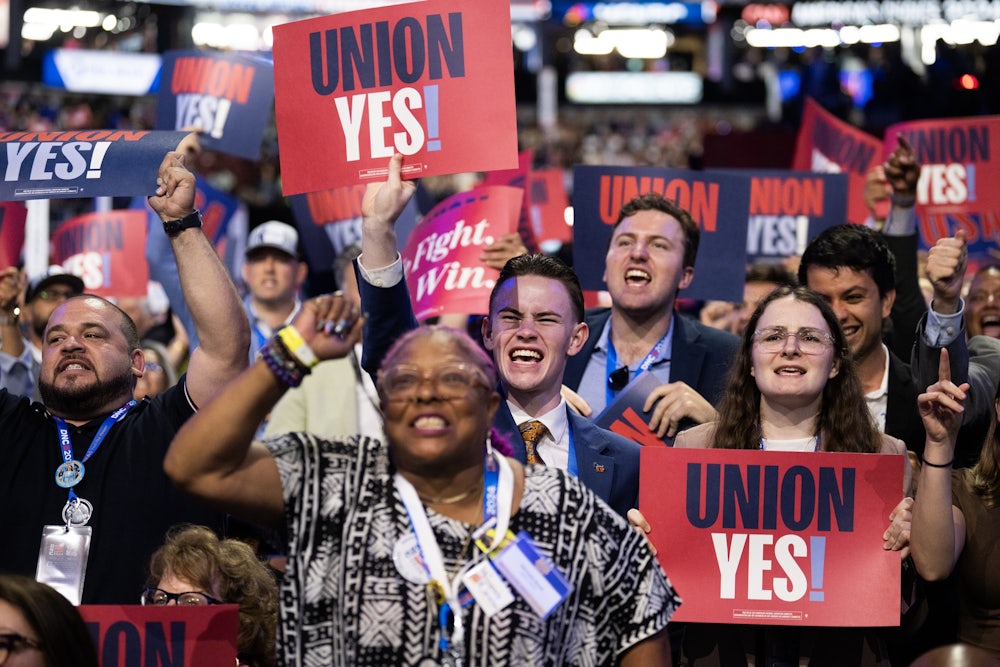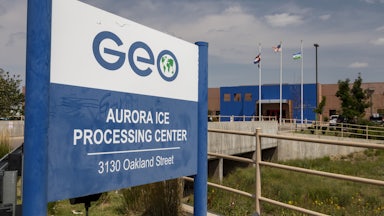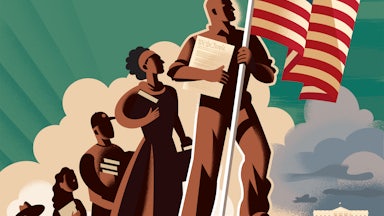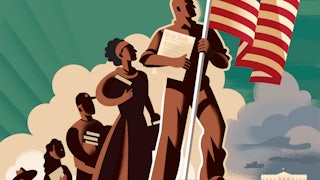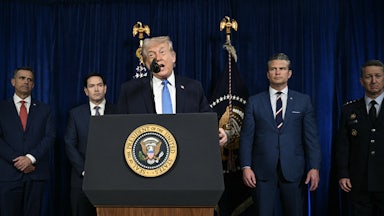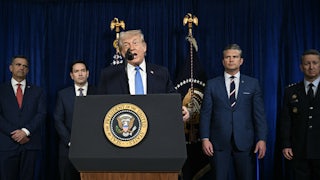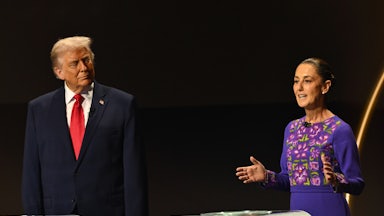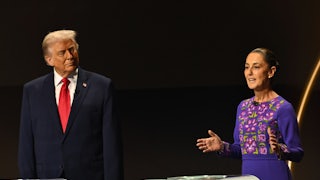For my entire adult life, Labor Day has prompted commentators to pronounce the labor movement dead. Occasionally you’ll see somebody argue that organized labor is regaining strength, but the evidence is always anecdotal. Final word must go to the Bureau of Labor Statistics’ annual report on union membership, which is perennially, relentlessly, dismal. Union density (i.e., the percentage of jobs covered by a union contract) is today half of what it was when those “Labor is dead” commentaries started appearing in the early 1980s. In the private sector, union density is 6 percent, down from its historic peak of 34 percent at the end of World War II. Excepting a tiny bump here or there, union density has tumbled steadily downward since the 1950s.
I will now attempt to make a plausible case for optimism about labor’s future. We begin with the assumption that union density, however definitive, is a lagging indicator. Unions won’t come back until union density comes back, but maybe something else—some kind of catalyst—has to emerge first.
One such catalyst might be popularity. As recently as 2009, unions were unpopular; Gallup showed only 48 percent approved of them (against 45 who disapproved and 7 percent who had no opinion). That was an outlier; in most years, labor’s approval rated somewhere between 50 and 60 percent. But after 2009’s dismal showing, labor’s approval rating started climbing. After Donald Trump was elected president it climbed into the low 60s and then the high 60s. This year, unions’ approval rating is 70 percent, the highest it’s been since the mid-1960s (with the exception of 2022, when it was 71 percent). People don’t just approve of unions; they like them a lot. Even some Republicans—according to Pew, more than one-third—like labor unions. Among moderate Republicans, more than half view unions favorably, and among conservative Republicans more than one-quarter do.
Another catalyst, or indicator, of imminent recovery might be union organizing. A new report by the sociologists Ruth Milkman and Joseph Van Der Naald of City University of New York says organizing is on the rise as well. Petitions to the National Labor Relations Board, or NLRB, to hold union elections rose after Joe Biden was elected president, especially during the last three years, and so did union victories in NLRB elections. Petitions and union victories had both mostly declined during the previous 20 years.
CUNY’s statistics don’t include instances in which management recognizes a union voluntarily based on the informal collection of union authorization cards (“card check”). The Center for American Progress claimed last year that voluntary recognition is increasing too, but it offered only anecdotal evidence. According to the CUNY report, voluntary recognitions today represent 8 percent of all successful union drives. That doesn’t seem very many. When a union asks the boss to recognize it, the boss still usually says no.
Next, let’s consider demographics. Much like the Democratic Party, the labor movement is becoming more amenable to Joe College. Indeed, the proportion of college grads who belong to a union now exceeds slightly the proportion of high school grads who do (9.5 percent versus 9.2 percent, per CUNY). This reflects stepped-up organizing efforts in prestige fields where wages are falling, such as journalism and higher education, and, over the longer term, the larger role of public employee unions, which scarcely existed before the 1960s. Another likely driver is corporations’ growing solicitude since the 1970s toward stockholders at the expense of employees.
I don’t know whether to count the gentrification of organized labor a favorable indicator, as Noam Scheiber of The New York Times seems to, or an unfavorable one. It will be a bad thing if it drives a deeper financial wedge between so-called skilled (i.e., college-educated) and unskilled labor. At the labor movement’s height, a union card was the financial equivalent of a college degree. If a union card now becomes, instead, a sort of accessory to a college degree, then the result will be greater economic inequality.
But on the other hand: Unionization tends to breed more unionization. As more college professors and newspaper reporters vote union, the proletariat may resolve not to be left out. In the 1970s, economists thought labor organizing increased economic inequality. That turned out to be wrong. Let’s hope it continues to be wrong. Labor strength has always been, and, I believe, still remains, a central working-class concern.
Which brings us to the 2024 election. To become president, a Democrat needs to win a working-class majority. That’s been my mantra. Lately, polls have shown support shifting from Trump to Harris, which is good. But Harris still isn’t winning the working class, and that’s bad. As Ruy Teixeira wrote, August 22, on The Liberal Patriot, “Democrats Are Super Happy, Working Class Voters Are Not.”
Teixeira cited a Washington Post-ABC News-Ipsos poll conducted August 9 to 13 that showed Harris leading Trump among all registered voters, 49 percent to 45 percent, but trailing Trump among working-class voters (defined as those who lack a college degree), 44 percent to 51 percent. Biden lost this group by two percentage points in 2020, according to exit polls; Harris is behind by seven. As with Biden in 2020, the problem appears to be leakage among nonwhite (mainly Latino) working-class voters. In 2020 Biden won nonwhite working-class voters by 46 percentage points, which sounds great until you consider that in 2016 Hillary Clinton won this group by 50 percentage points. Harris, who is nonwhite, leads among that group by considerably less than even Biden did: 29 percentage points. That’s really bad.
Look, maybe I’m wrong. Maybe Harris can win without a working-class majority, just as Biden did in 2020. Biden was the only Democrat to do this going back 100 years. He made himself an exception because he was running against Trump, who was mishandling the Covid pandemic in spectacular fashion. Maybe Harris can repeat Biden’s trick. Trump is, after all, the Republican nominee once again. He’s no longer botching the government’s response to a deadly pandemic, but perhaps his conviction on 34 felony counts, plus his increasingly erratic personal behavior (most recently concerning Arlington National Cemetery), will prompt some sort of equivalent revulsion among college-educated voters of the sort that gave Biden his crucial boost. Harris does a little better with college-educated voters than Biden did.
Still, I wouldn’t count on it, because the overwhelming majority of voters are not college graduates. As I noted last week, Harris has a detailed labor platform close to hand in the form of a 2022 report from a task force she chaired on worker organizing. Yet I’ve never heard Harris even say the words “worker organizing.” Trump has close to hand Project 2025’s Mandate for Leadership, which would, among other things, undermine union contracts, eliminate the voluntary recognition of unions, invite states to opt out of overtime rules, eliminate child labor protections … and so on. (Click here for an overview by the AFL-CIO.) If voters start actually believing Trump’s claim that he knows nothing about Project 2025, there’s always Trump’s own terrible labor record as president to fall back on. And don’t forget Trump telling Elon Musk, less than a month ago: “You walk in, you say, ‘You want to quit?’ They go on strike, I won’t mention the name of the company, but they go on strike and you say, ‘That’s OK, you’re all gone. You’re all gone. So, every one of you is gone.’”
Especially today, Harris needs to publicize her strengths and Trump’s weaknesses in supporting organized labor. Breezy generalities won’t do the job. The New York Times reported last week that Harris’s wealthier donors are trying to persuade her not to raise their taxes. Lord only knows what they’ll say when they find out she chaired a task force to strengthen and expand union representation. But pledging to build on President Joe Biden’s pro-labor policies, reciting specifics, is the fastest and best way to reach working-class voters whose support she needs. Things may be looking up for labor, but without a Democrat in the White House its winning streak won’t continue.
